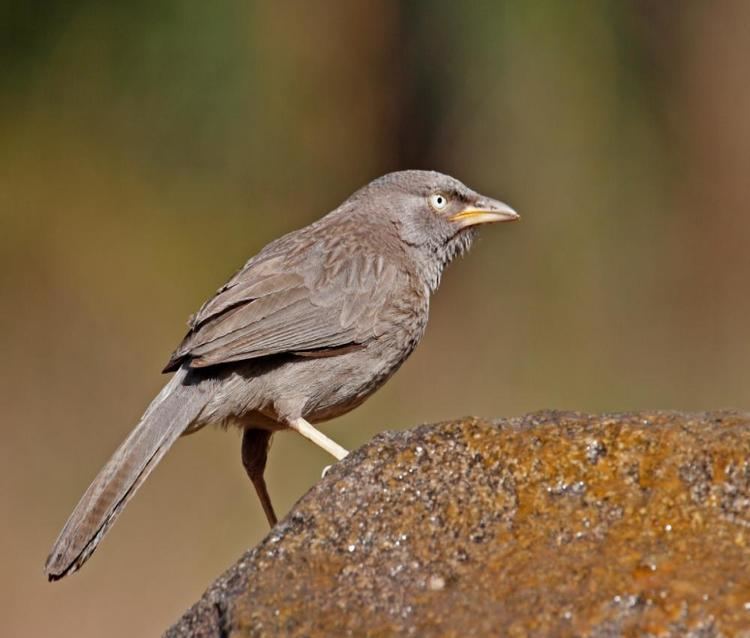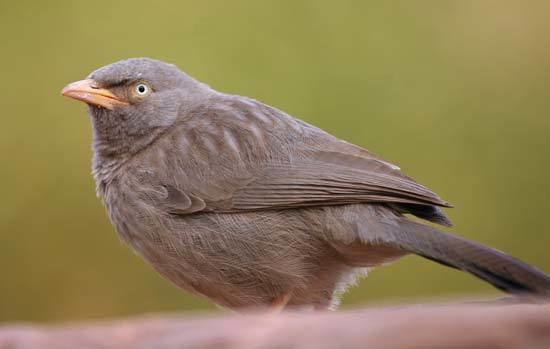Order Passeriformes Higher classification Turdoides | Phylum Chordata Family Leiothrichidae Scientific name Turdoides striata Rank Species | |
 | ||
Similar Bird, Turdoides, Yellow‑billed babbler, Large grey babbler, Common babbler | ||
Amazing bird sounds from the jungle babbler nagesh vannur karnataka wildlife india
The jungle babbler (Turdoides striata) is a member of the family Leiothrichidae found in the Indian subcontinent. They are gregarious birds that forage in small groups of six to ten birds, a habit that has given them the popular name of Seven Sisters or Saath bhai in Bengali with cognates in other regional languages which means "seven brothers".
Contents
- Amazing bird sounds from the jungle babbler nagesh vannur karnataka wildlife india
- Bird call of jungle babbler turdoides striata seven sisters seven brother
- Description
- Taxonomy and systematics
- Behaviour and ecology
- In culture
- References

The jungle babbler is a common resident breeding bird in most parts of the Indian subcontinent and is often seen in gardens within large cities as well as in forested areas. In the past, the orange-billed babbler, Turdoides rufescens, of Sri Lanka was considered to be a race of this babbler, but is elevated to a species.
Bird call of jungle babbler turdoides striata seven sisters seven brother
Description

The jungle babbler's habitat is forest and cultivation. This species, like most babblers, is non-migratory, and has short rounded wings and a weak flight. The sexes are identical, drably coloured in brownish grey with a yellow-bill making them confusable only with the endemic yellow-billed babblers of peninsular India and Sri Lanka. The upperparts are usually slightly darker in shade and there is some mottling on the throat and breast. The race T. s. somervillei of Maharashtra has a very rufous tail and dark primary flight feathers.The jungle babbler can be separated from the white-headed babbler by the dark loreal zone between the bill and the eye as well as the lack of a contrasting light crown. The calls of the two species are however distinct and unmistakable. The jungle babbler has harsh nasal calls while the white-headed babbler has high pitched calls. Another babbler that is similarly found in urban areas is the large grey babbler, however that species has a distinctive long tail with white outer tail feathers.

The jungle babbler lives in flocks of seven to ten or more. It is a noisy bird, and the presence of a flock may generally be known at some distance by the harsh mewing calls, continual chattering, squeaking and chirping produced by its members.
Taxonomy and systematics
The species was described in 1823 under the name of Cossyphus striatus and was based on a specimen from Bengal. There are several named geographically isolated subspecies that show plumage shade differences. Former race rufescens of Sri Lanka is considered a full species. The widely accepted subspecies include:
Some older literature can be confusing due to some incorrect usage such as Whistler (1944, Spolia Zeylanica, 23:131), who used the name affinis (which could be confused with Turdoides affinis when intending to indicate the subspecies of striatus found in peninsular India.
Behaviour and ecology
These birds are gregarious and very social. They sometimes form the core of a mixed-species foraging flock. They feed mainly on insects, but also eats grains, nectar and berries. The groups maintain territories and will defend it against neighbours but will sometimes tolerate them. For their size, they are long lived and have been noted to live as long as 16.5 years in captivity.
When foraging, some birds take up a high vantage point and act as sentinels. They are known to gather and mob potential predators such as snakes.
Young birds have a dark iris. Older birds have a pale creamy colour and it has been found that the iris has a dark epithelium which become invisible when the muscle fibres develop in the iris and make the dark basal colours invisible and then appear cream coloured.
They breed throughout the year; peak breeding in northern India has been noted between March–April and July–September. Birds are able to breed after their third year. The nest is built halfway in a tree, concealed in dense masses of foliage. The normal clutch is three or four (but can be up to seven) deep greenish blue eggs. In northern India, birds breeding during June–September tend to be parasitized by the pied crested cuckoo and sometimes by the common hawk-cuckoo. Helpers assist the parents in feeding the young. Post fledging survival is very high.
Birds fledge and females tend to leave their natal group after about two years. Birds within a group often indulge in allopreening, play chases and mock fights. When threatened by predators, they have been said to sometimes feign death.
In culture
These birds are very common near towns and cities particularly in northern India and are well known for their habit of moving in groups giving them the local name of "Sath Bhai" which means seven brethren but translated by the English in India to "Seven sisters". Visitors to India were very likely to notice these vocal and active birds and Frank Finn notes an incident during the Colonial period in India:
Some years back, a new Viceroy was being shown the wonders of his temporary kingdom, and among these the Taj at Agra held, of course, an important place. Arrived before the glorious monument of Eastern love and pride, the artless Aide-de-Camp was mute; the gilded staff were still as Kipling says, in anxious expectation of the comment of His Excellency. But this, alas when it came was merely the remark: "What are those funny little birds?" The shock must have been the greater for the fact that the mean fowls thus honoured were it seems, of that singularly disreputable species which is commonly known in India as the "Seven Sisters" or "Seven Brothers," or by the Hindustani equivalent of sat-bhai.
